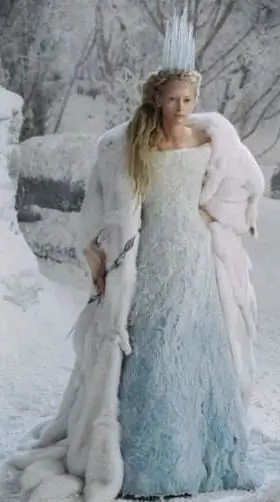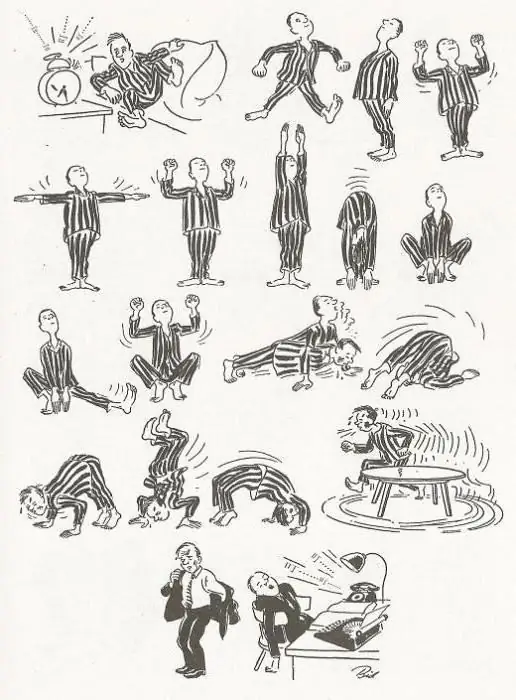2025 Author: Leah Sherlock | [email protected]. Last modified: 2025-01-24 17:46:37
Herluf Bidstrup is a cartoonist from Denmark, whose works, sparkling, lively, show the truth, exposing the vices of society. A significant part of his work is dedicated to the fight against fascism.

Biography
Herluf Bidstrup was born on October 10, 1912 in Berlin. He has been drawing since early childhood. Herluf himself recalls that as a child, as soon as pencils or crayons fell into his hands, he began to draw. Sometimes, falling asleep, he drew "drawings" in the air with his finger. Parents encouraged their son in his endeavor. His father, a decorator and painter, became his first teacher and critic, and he also broadened his son's horizons with stories about the various countries he had visited. And there was something to tell. Even before the First World War, his father, having become a painter, left Denmark and lived, earning his craft. He wandered from country to country for twelve years, even living in countries such as Palestine and Egypt, and then, returning to his homeland, he traveled through Germany. There Herluf Bidstrup's parents met and fell in love.
First War
Herluf Bidstrup is a witness of two world wars. World War I broke out when he was only two years old. In his memoirs hewrites that he remembers how his family was starving. For a long time they ate only kohlrabi cabbage. His father was suspected of espionage and was soon arrested, therefore, after leaving prison, Bidstrup decided to leave the country with his family. In Denmark, everything was fine with food, but housing problems began. The young family managed to get an apartment only after a few years. Soon the Spanish flu began, which almost left the future artist an orphan. In such difficult conditions, the best consolation for a child was to escape into a fantasy world.

Laughter is the best ally
Even in his early childhood, the Danish artist Herluf Bidstrup noticed that his drawings were perceived by others not as he would have liked. Over time, reflecting on this, he began to understand exactly which elements produce the most comical impression. Later, he deliberately began to use them in his work to make the audience laugh. During his school years, this ability of his developed even more, sometimes he even made sketches on the blackboard, entertaining teachers and classmates. Herluf Bidstrup painted portraits of teachers and schoolmates and it was then that he realized how powerful a successful caricature can be.

What is the essence of the cartoon?
These drawings are marked by deliberate exaggeration, which is often perceived as a distortion, but the cartoonist Herluf Bidstrup never distorted reality. The caricature should give the viewer the same impression as the artist.produced a living object. It is easy to understand that a two-dimensional black and white drawing, which, moreover, is significantly reduced, is unlikely to be able to give the impression of a real object, so the lost must be replaced in another way.
Herluf Bidstrup says that a caricature made of a political opponent is the most successful when it depicts not only the appearance of a particular person, but also the policy pursued by him. Yes, and the main blow is carried out precisely on it, and not on the personality of a person. For example, if the cartoon character is a bourgeois or social democratic politician, he can be portrayed as fat, smug, and generally unattractive. In this case, the cartoon is an illustration of the fact that such a policy leads to hunger and impoverishment of the working people. A cartoonist should always remember that his work should reflect the original even more fully than a photograph.
Herluf Bidstrup admits that drawing a caricature is very difficult. He says that rulers and squares will not help in this matter, even artistic talent is not the main thing, because the essence of such an image is not in beauty. Seeing an unsuccessful caricature, many justify the artist's mistake by saying that it should not look like the original. However, Herluf Bidstrup is adamant: if the cartoon did not hit the target exactly, then it no longer has the right to be called that.

Education
Herluf Bidstrup recalls that his future was determined as if by itself, after he spent ten years in school and passed his final exams well. Gradually, the pencils in his hands were replaced by oil paints. In the senior classes of a general school, he began to attend an art school, where he studied projection, geometry, and the laws of perspective. All this was the preparation necessary for admission to the Academy of Arts. After leaving school, Bidstrup studied at the art school for another year.
The Royal Academy of Arts was not so impregnable and accepted the young cartoonist. Bidstrup recalls that it was difficult for him to draw from sitters. He was unable to maintain interest in objects that stood for hours every day like a statue. All the drawings made in my free time were images of people in motion. In the pocket of the future cartoonist, there was always a notebook in which he made sketches of everything he saw during the day.
During Bidstrup's studies at the Academy of Arts, the political situation in the world worsened. It was in those years that the Reichstag in Berlin was set on fire, Hitler came to power, and Dimitrov heroically fought the Nazis at the Leipzig trial. These events were of great interest to the students of the Academy.

Style Search
After graduating from the Academy, Herluf Bidstrup again faced the realities of life. What is a young painter to do? He decided that the most important thing was to find his own style. Yes, and time itself dictated the rules: the age of individualism had come, where each artist was obliged to leave a mark on painting, to show his remarkableness. For a short time he was fascinated by the slogans of the abstract artists, many of whom had studied with him.on one bench. Abstract painting is an opportunity to express your individuality without spending too much time. Adherents of this "camp" believed that it makes no sense to try to reflect reality, if with the help of a camera you can do it in a split second and ten times more accurately. But an abstract painting is a pure work of art. However, Herluf Bidstrup, who was primarily interested in the living person, was attracted to abstractionist slogans only because he could not reflect reality and his worries by creating realistic images: fascism and the danger of a new war.
First publications
Of course, Bidstrup could start painting paintings calling for peace, but the likelihood that they could be exhibited in crowded exhibitions was almost zero. Who will exhibit a young, unknown artist? In addition, most of the inhabitants of Denmark did not attend exhibitions, because in recent years, mainly the results of the experiments of artists were exhibited there.
One evening, Bidstrup was sitting at the radio and listening to Hitler's speech, emotional, hysterical. It was far from the era of television, but the young artist imagined the speaker so vividly that he immediately made several sketches. The result of this work was the first series of drawings. The anti-fascist magazine Kulturkampen published cartoons of Hitler. Beneath them, quotations from the speech were printed, and the series was given the general title "Bidstrup Drawings. Text by Adolf Hitler." Later this magazine published many others.anti-fascist drawings of Herluf.

Legacy
It took many more years before Herluf Bidstrup received recognition. He left to his descendants more than five thousand drawings, which were published in whole books. In the USSR, they were published in huge editions, as he was considered a progressive artist, exposing the vices and ulcers of capitalism. He became an honorary member of the Academy of Arts of the USSR. The famous cartoonist died in 1988 in the city of Allerode (Denmark). He was 76 years old. Bidstrup's contribution to the development of caricature is difficult to overestimate. Moreover, he has ensured that this art form can influence and shape public opinion even more than others.
Recommended:
Alexey Merinov, artist and cartoonist

Everyone loves to laugh, but the cartoons of Alexei Merinov not only make you laugh, but make you think and become a little better. Satire and humor, irony and grotesque, fairy tale and today's reality, his own recognizable graphic style - all this is about the artist Alexei Merinov. About the artist, his works, the features of his work and described in the article
For he alth and courage for - a drop of the Danish king

In his song, Bulat Okudzhava admits that from childhood he believed in the power of the healing royal drops, they supposedly treated any ailment, and were able to resist the blows of sabers and the whistle of bullets, and helped to tell the truth. The author believed to believe, but how much he trampled the roads of life, but he never found the cherished medicine
The most famous fairy tale written by a Danish author is "The Snow Queen"

"Well, let's get started! When we reach the end of our history, we will know more than we do now.” With these words begins one of the most famous fairy tales in the world, which was written by a Danish author - "The Snow Queen"
Peter Heg: the work of a Danish writer

Peter Heg is a Danish writer who became world famous with the publication of Smilla and Her Sense of Snow in 1992. A bestseller with a detective line, a strong sense of style, exciting plot twists, an understanding of the flow of life with its turmoil, troubles and loneliness, was published in several countries around the world. Peter Heg is a rather interesting personality who does not make contact with either the press or readers
Gerda Wegener, Danish artist: biography, personal life, creativity

This story ended with the world's first gender reassignment plastic surgery, as a result of which the artist's husband, Einar Wegener, became a woman, making both himself and his ex-wife famous all over the world. However, the desire to become a mother cost Einar-Lili his life

